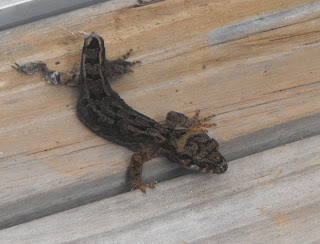Tuateawa has more than it's fair share of iconic species. They let us know that things are going along quite well. Their absence or decline would be a real cause for concern because it would indicate that they are having problems. It could also indicate that the system upon which they depend is also under a bit of stress. It is natural to pay less attention to more secretive species but they could also tell us something about the state of our environment.
NZ has at least 90 species of lizard. However many do not live on the main islands. On the Coromandel mainland there are 5 skink species and 5 gecko species. If you included the Tuateawa offshore islands the number would more than double. In the absence of mammals and effective pollinating insects they have had a significant role as pollinators and seed distributors. They are however quite vulnerable to introduced mammalian predators. Some species must have some degree of preadaptation and have survived, but probably in much smaller numbers. How crucial lizards are to the overall ecology is unsure. Their decline is, however a cause for concern. In Tuateawa the numbers seem to be on the increase which one must assume is due to the actions of Habitat Tuateawa. Species not yet known may become apparent as a result of the decreased predator pressure.
There are unique things about NZ lizards. They are particularly well adapted to our colder climate. Through most of the world lizards reproduce by egg laying. The egg develops if it is laid in an appropriate temperature environment. Lizards are, however, cold blooded and their development is temperature dependant. If the egg is laid in a very cool spot successs is much less likely. NZ lizards are far superior. They retain their eggs within the females body and give live birth when the eggs hatch. The pregnant female can choose the best temperature environment, sunbathing when it is cooler and retreating into the shade when it is too warm. This probably also explains why our lizards are more active in the day and perhaps why we are more likely to see them.
Identifying lizards does have it's problems. Skinks are easily distinguished from Geckos. Skinks have a narrower, more pointed head. There scales overlap which makes them look smooth and shiny. The absolute giveaway is that they have a lower eyelid. How can I see that you probably think and you are almost certainly correct. However the eyelid keeps the eyeball moist so it has to blink. If it blinks it's a skink!

Geckos have much larger eyes. They are always open. They also have quite large tongues which they use to keep their eyeballs moist. Quite a party trick. Geckos are also more likely to be found up a tree rather than on the ground. They have pads on their toes made of multitudes of microscopic hairs. The suggestion is that these are electromagnetic and allow geckos to climb the smoothest surface. Identifying the species is a demanding job. Only NZ has green geckos. Only one green species is known from the Coromandel and that is the Elegant Gecko. I have never seen one outside of a cage but they do inhabit manuka/kanuka scrub and are often associated with the scrambler plant poehuehue. I am sure that there are quite a few Tuateawans much better informed than I . It would be great to get some comments! There seems to be a lot of technical detail about identifying other species. The most variable thing between species seems to be colour of the tongue, lips and mouth lining and it is probably the way members of a species identify each other for mating purposes. Another easily identified gecko is the striped gecko, not because of it's stripes but because it is light buff to tan in colour. This just leaves three species. The one pictured is probably the forest gecko but you could also find the Pacific Gecko or the Matua Gecko. The pictured gecko has been hanging around the bach for sometime. Usually it is partially obscured in the roof. On this occasion it spent a considerable time sunning itself on the deck. Obviously it must have had some kind of unpleasant encounter as it lacks a tail and one limb.

The skink pictured is at the back of the boulder beach and these are often to be seen as you walk along the shore. All the skinks here seem to be black. It is probably the Shore Skink but there is a similar species, the only egglaying NZ species, called the diving skink and it lives in similar areas. It is also recorded for Cuvier Is. The skink that we have on our sections is the Copper Skink. However it is hard to be positive as there is an egglaying Australian species with a dark rather than a copper stripe and another called the Moko Skink.
Any comments on this would be really welcome. There are so many talented people in Tuateawa that I am sure one must be an herpetologist!
No comments:
Post a Comment